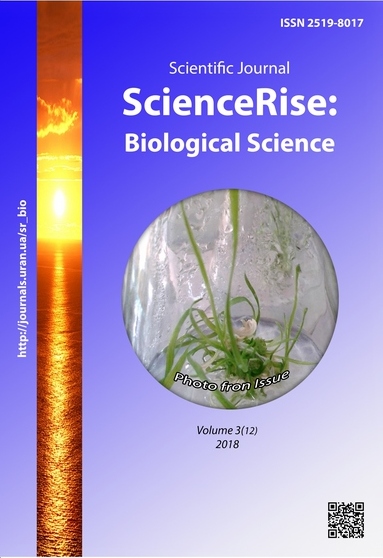Coronarographic and magnetic-resonant study of the myocardium of rats for artificial hypobyosis
DOI:
https://doi.org/10.15587/2519-8025.2018.135765Keywords:
hypobiosis, hypothermia, hypercapnia, hypoxia, myocardium, coronography, tomography, vessels, atriums, ventriclesAbstract
The one of newest future methods of anesthesia is the state of artificial hypobiosis. For detail studying this method with a possibility of its further introduction in clinical practice, and before – in conducting clinical studies, it is necessary to have specified data of pre-clinical studies. Among important methods that characterize the completeness of pre-clinical data are magnetic resonance imaging procedure and coronography of key vessels of the myocardium of rats. Coronography – is the rontgenological method of research that demonstrates the structural deformation and speed of the bloodstream of key vessels of the heart. Its principle is based on introducing a contrast substance including iodine in the peripheral vein of a patient with the further rontgenological scanning during several full cycles of circuit. In its turn, the magnetic-resonance imaging procedure of the myocardium – non-invasive method of the structural-diagnostic study characterizes 3D-model using the three-dimensional reconstruction of the cardiac muscle, and also demonstrates the volume of cardiac chambers, characterizing the dynamics of changes of the wall thickness. That is why just these methods were chosen for the detail characteristics of structural-functional changes of the myocardium of rats at artificial hypobiosis. In experiments there were used white outbred male-rats with mass 180-200 g, kept in standard vivarium conditions. The animals were divided in groups: control (intact animals) and experimental (artificial hypobiosis). The number of animals in each group n = 7. Experiments were conducted in correspondence of requirements of the “European convention about protection of vertebral animals, used for experimental and other scientific purpose” (Strasburg, France, 1985), According to general ethical principles of experiments, accepted by the first national congress of Ukraine on bioethics (2001). As a result of the conducted studies, it was demonstrated that the state of artificial hypobiosis favors the essential narrowing of the clearance of great vessels of the myocardium of rats, decrease of the frequency of heart contractions in six times comparing with the control one, and also decrease of the chambers of the cardiac muscle
References
- Morozova, V. I. (2013). Functional activity of mitochondria of hepatocytes and cardiomyocytes of rats for artificial gipobiosis. Kyiv, 21
- Alukhin, Yu. S., Ivanov, K. P. (1998). A model of winter hibernation in a non-mammalian mammal upon cooling its brain to 1–4 °C. Adapt. organism to nature. and eco-sots. environmental conditions. Magadan, 6–7.
- Schäfer, R., Wiskirchen, J., Guo, K., Neumann, B., Kehlbach, R., Pintaske, J. (2007). Aptamer-Based Isolation and Subsequent Imaging of Mesenchymal Stem Cells in Ischemic Myocard by Magnetic Resonance Imaging. RöFo– Fortschritte Auf Dem Gebiet Der Röntgenstrahlen Und Der Bildgebenden Verfahren, 179 (10), 1009–1015. doi: http://doi.org/10.1055/s-2007-963409
- Vykhovanets, V. I., Melnychuk, S. D. (2008). History of the development of models of artificial suppression of living organisms. Scientific herald of NAU, 127, 65–68.
- Kalabukhov, N. I. (1985). Hibernation of mammals. Moscow: Science, 168.
- Melnichuk, S. D., Vakhovets, V. I. (2005). The Influence of the Conditions of the Artificial Hypobiosis on the Energy Exchange in Rats. Ukrainian Biochemical Journal, 77 (3), 131–135.
- Melnichuk, S. D., Melnychuk, D. O. (2007). Animal hypobiosis (molecular mechanisms and practical values for agriculture and medicine). Kyiv: Publishing Center of NAU, 220.
- Melnichuk, D. O., Melnichuk, S. D., Arnauta, O. V. (2004). Influence of the carbon dioxide medium on the preservation of erythrocytes in the canned blood of animals. Scientific Herald NAU, 75, 163–165.
- Melnichuk, S. D. (2001). Basic indicators of acid-base blood and metabolic processes in the case of hypobiosis and general anesthesia for amputation of the limb. Ukrainian Biochemical Journal, 73 (6), 80–83.
- Melnichuk, S. D., Rogovsky, S. P., Melnychuk, D. O. (1995). Features of acid-base equilibrium and nitrogen exchange in the body of rats under conditions of artificial gipobiosis. Ukrainian Biochemical Journal, 67 (4), 67–75.
- Melnichuk, S. D., Vychanets, V. I. (2005). The Influence of Conditions of Artificial Hypobiosis on Energy Exchange in Rats. Ukrainian Biochemical Journal, 11 (3), 131–135.
- Severina, E. S. (Ed.) (2004). Biochemistry. Moscow: GEOTAR-MED,784.
Downloads
Published
How to Cite
Issue
Section
License
Copyright (c) 2018 Anna Umanska, Dmytro Melnichuk, Liliia Kalachniuk

This work is licensed under a Creative Commons Attribution 4.0 International License.
Our journal abides by the Creative Commons CC BY copyright rights and permissions for open access journals.
Authors, who are published in this journal, agree to the following conditions:
1. The authors reserve the right to authorship of the work and pass the first publication right of this work to the journal under the terms of a Creative Commons CC BY, which allows others to freely distribute the published research with the obligatory reference to the authors of the original work and the first publication of the work in this journal.
2. The authors have the right to conclude separate supplement agreements that relate to non-exclusive work distribution in the form in which it has been published by the journal (for example, to upload the work to the online storage of the journal or publish it as part of a monograph), provided that the reference to the first publication of the work in this journal is included.









